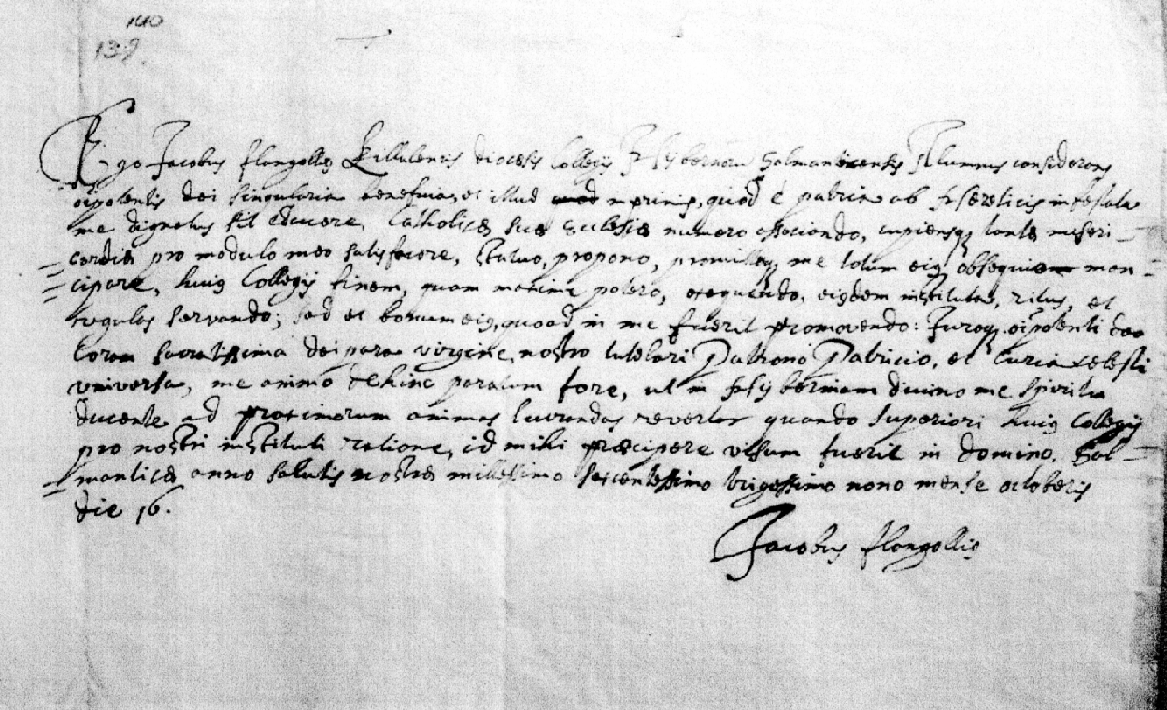This seventeenth century silver chalice reposes with the Bishop of Killala in County Mayo, and has been the subject of academic examination (Chapple). It is interesting to note that the chalice was commissioned during the Rebellion in Ulster (1641 - 1650) which was terminated by Oliver Cromwell's military campaign (1649 - 1650). This was also the era of the epic genealogical compilations by the last true bards in Connaught. The religious persecution under Elizabeth I and James I lead to the suppression of the monastic schools in Ireland in which the clergy for the most part received their education. It became necessary, therefore, to seek education abroad, and many colleges for the training of both laymen and clergy were founded on the Continent, at Rome, in Spain and Portugal, in Belgium, and in France.
The most famous of the Irish colleges in Spain was that of Salamanca, founded, at the petition of Father Thomas White, S. J., by a decree of Philip III, dated 1592, and opened in 1593 with the title: El Real Colegio de Nobles Irlandeses. James Flannelly (Jacobus Flangollis, in Latin) of Killala diocese attended this college, and took his oath on 16th October 1639. We have obtained a digital photograph of the original oath (copied below) from Maynooth College, and have produced the following transcript and translation. Special thanks are due to Fr. Des Byrne, PP Knockmitten, for his scholarly translation of old Latin.
Ego Jacobus Flangollis Killalensis Diocesis Collegiis Hibernorum Salmancansis Alumnis considerans O(mn)ipotentis Dei singularia beneficia, et
illud imprimis quod e patria ab haereticis infestata me dignatus sit educere, Catholicae suo ecclesiae numero associando, cupiensq(ue) tante misericordia
pro modulo meo satisfacere, statuo, propono, promittoq(ue) me totum ei(u)s obsequio mancipare, huis Collegiis finem, quam maxime potero, exequendo,
ei(u)sdem instituta, ritus, et regulas servando; sed si bonum ei(u)s, quoad in me fuerit promovendo:
Juroq(ue) O(mn)ipotenti Deo coram sacratissima
Deipara Virgine nostro tutelari Patrono Patricio et curia totali universa me animo dehinc paratum fore, ut in salis benignum divino me spiritus
ducente ad proximorum animas lucrandas reverter quando superiori huis collegiis pro nostri instituti ratione, id mihi praecipere visum fuerit in Domino.
Salmantice anno salutis nostrae millissimo sascontissimo trigossimo nono mense octoberis die 16. Jacobus Flangollis
I, James Flannelly, of Killala Diocese, a student of this Irish College in Salamanca, aware of Godís singular blessings towards me, and especially
aware that I was privileged to be taken out of my country, infested with heretics, associated with the Catholic Church, and desiring to avail myself
of such mercy I declare myself ready to carry out the ideals of this same Institution (in so far as I can) and to do my best to promote the ideals
of the said Institute.
I swear to Almighty God before the Blessed Virgin, our titular patron Patrick and the whole heavenly court to publicly
advance to the sacred order of the Priesthood and afterwards, under the guidance of the Holy Spirit, to work for the salvation of souls in Ireland
as the authorities of this Institute may direct. Given at Salamanca in the year of our salvation 1639, on the sixteenth day of October.
James Flannelly

The overall height of this silver chalice is 171 mm, and it weighs 290g. The bowl is parabolic in profile, with an everted lip and gilt internally. The bowl is 60 mm high and 80 mm in diameter. There are no hall marks on the chalice, but the high standard of workmanship suggests that it was crafted in Galway.
The stem is 51 mm long with a circular section of 10 mm diameter. The knop is lobed with a maximum diameter of 30 mm, and is decorated with three cherubs in high relief. The fine detail of the cherubs has been worn by centuries of use, but the original appearance may be deduced by reference to the cherubs on the Marquess of Bute's Chalice 1644, which is virtually identical and remarkably well preserved.
The foot is a concave hexagonal pyramidoid 60 mm high and widens to a hexafoil base of 111 mm diameter. It is decorated with a crucifixion scene, and fleurs-de-lys at each of the hexagonal edges. The Latin inscription reads ...
'Jacobus flanelly me fieri: fecit anno dni 1647'
[James Flannelly caused me to be made in the year of our Lord 1647]

